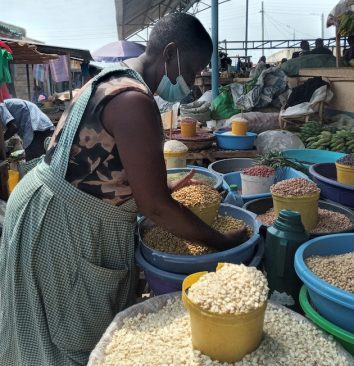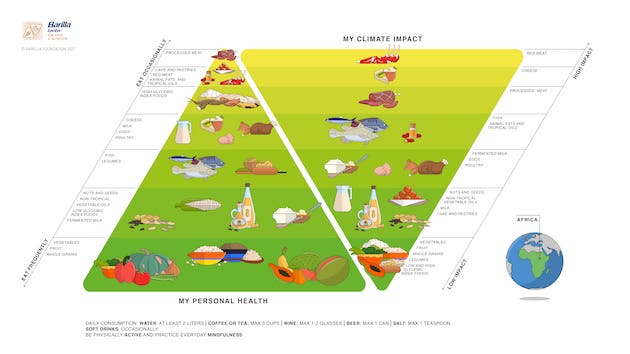High Yield Seeds
By Joyce Chimbi
Rahab Munene’s shoe-selling business crumbled at the height of COVID-19 in 2020. She traded the enterprise for a mobile grocery along the Thika Superhighway, Kiambu County.
“My son and I buy fruits, vegetables and cereals directly from farmers. This worked very well in the beginning because people did not want to leave their homes for fear of coronavirus. Today, food prices are very high, and many households are buying directly from farmers because it is cheaper,” she tells IPS.
“A 90 kg bag of maize is now going for at least $27 – up from $23 a month ago. Our business is no longer breaking even.”

In October 2021, the Kenya National Bureau of Statistics indicated that the cost of food in Kenya showed an unprecedented increase of 10.6 percent compared with the same month in 2020.
UN’s Food and Agriculture Organization (FAO) indicates a similarly unprecedented increase, by over 60 percent, of acute food insecurity in Africa over the past year.
In Africa, there is a need to overhaul the food systems to include nutritious crops and diets that are climate and severe weather resilient.
“Global food systems present a complex and multi-faceted set of challenges from farm to fork,” the Barilla Center for Food and Nutrition (BDFN) says. Using science and best practice, BCFN has developed a system of placing the Health and Climate Pyramids side-by-side. The Double Pyramid directly illustrates a balanced, healthy, and sustainable diet.

Faced with food insecurity exacerbated by the COVID-19 pandemic, BCFN has called for sustainable food solutions.
One of these solutions, says Desmond Kipkorir, a Kenyan-based seed systems analyst in East and Southern Africa, ensures that farmers have high-yielding seeds to match the myriad of challenges facing the African farmer.
The 2019 Access to Seeds Index notes that “less than 10 percent of the world’s smallholder farmers have access to improved and quality seeds that can halt and tolerate climate change impacts.”
Kipkorir tells IPS the most recent data shows despite a growing private seed sector to augment public seed sectors and extensive rural agro-dealers, farmers are still unable to access the high-quality seeds they need and on time.
“Seeds systems involve a lot more than the production of seeds. They include all the factors that lead to the timely delivery of produced seeds to farmers at an affordable price. As recent as 2016, up to 90 percent of farmers in Africa relied on informal seed systems,” he says.
He says that uncertified seeds cannot counter the threats posed by climate change and extreme weather, land degradation and reducing farmlands, water and energy constraints, and an ever-growing demand for food in tandem with a growing population.
“Informal seeds systems are outside the control of government agencies. The quality of unregulated and uncertified seeds is too poor to address today’s challenges. Seeds saved from previous harvests, borrowed from neighbours and those bought from local markets are lacking in many aspects,” Chelangat Ochieng from the Ministry of Agriculture tells IPS.
“Uncertified seeds are often available, accessible and affordable to farmers. But they are not adaptable. They lack germination vigour and disease resistance.”
Experts such as Kipkorir warn that the existing yield gap will only widen and, with it, a rise in food prices.
Ochieng says the Agricultural Commodity Price Index stabilized in the third quarter of 2021. All the same, the price index is 14 percent higher than it was in January 2021.
“Maize and wheat prices are 44 percent and 38 percent higher, respectively, than their pre-pandemic, January 2020, levels,” the index indicates.
Confirming challenges facing Munene’s mobile grocer, the index shows high retail prices. Similarly, other indices confirm high food price inflation at the retail level globally.
FAO’s Food Price Index, a measure of the monthly change in international prices of a basket of food commodities, released in November 2021, showed the fourth consecutive monthly rise in the value of the food price index.
Prices for cereals and dairy rose significantly, followed by sugar and that the November 2021 index was at its highest level since June 2011.
“Climate change is here with us, and population growth is placing a lot of pressure on available farmland. Governments and the private sector need to strengthen three pillars of food security, quality of seeds, input and good agricultural practices,” Kipkorir tells IPS.
Against this backdrop, the African Seed Access Index, a seed industry research initiative, indicates that national seed systems on the continent are at varying stages of development.
Kenya, South Africa, Zimbabwe, and Zambia have established mechanisms for seed inspection and that Mozambique, Malawi, Ghana, Nigeria, and Tanzania are on track.
Kipkorir says this is a step in the right direction but decries the generally high cost of certified seeds. He urges governments to subsidize seed prices to ensure that farmers plant seeds that can withstand climate, weather risks and crop diseases.
He calls for maize seed subsidies in the region. He warns that even more severe food insecurity looms if farmers do not access quality, high yielding maize seeds.
According to the FAO, maize is a staple and a critical food security crop in sub-Saharan Africa, with more than 40 million hectares of farmlands dedicated to maize farming in at least 32 countries in the region.
The African Seed Access Index shows that Western and Central Africa lag behind other regions of Africa in seed company presence and investments in local seed business activities, including seed breeding, production, and processing.
Overall, the Index notes significant progress in Kenya, South Africa, Zambia, and Zimbabwe.
Other countries, such as the Democratic Republic of Congo, Liberia, and Madagascar, are notably lagging because they are characterized by “under-funded government seed agencies, poorly implemented seed regulations and a variety of weak private sector.”

